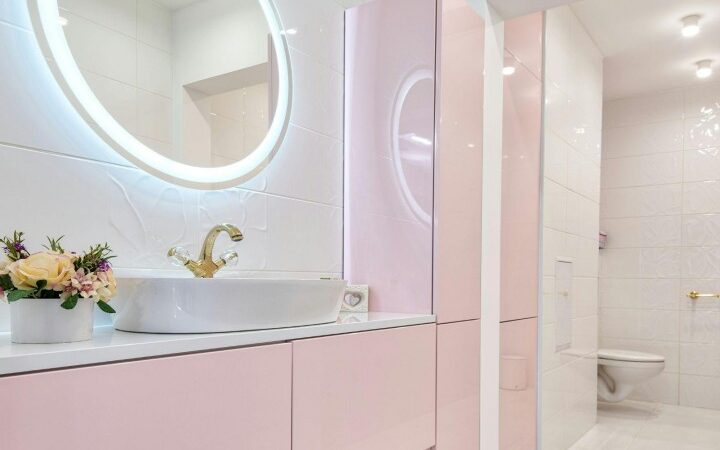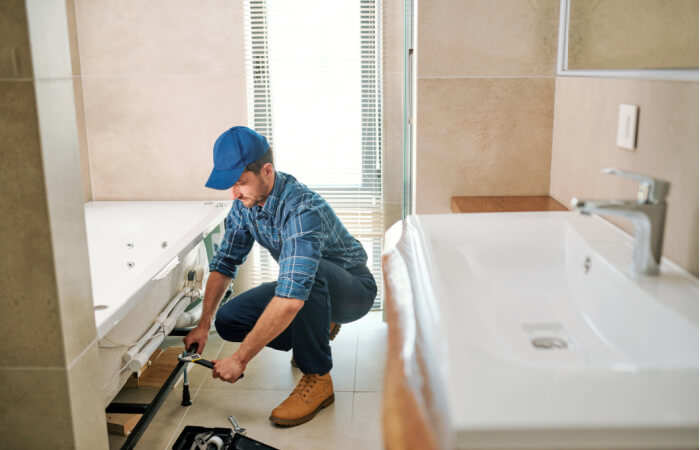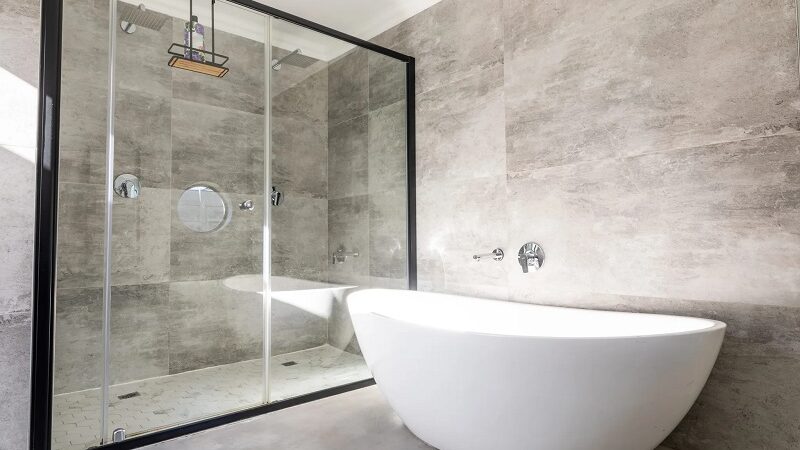Keeping your bathroom clean is essential to maintain hygiene
in your home. The issue is that they can appear totally fine even when germs are lurking around.
Cleaning it is one of those things we all don’t really want to do ourselves, but with the below guide you’ll be able to keep yours fresh with little effort.
Determining Frequency of Cleaning
The golden rule says that bathrooms should be cleaned once a week. While this is sufficient for basic maintenance, it’s interesting to note that certain germs take three weeks to grow.
This means that if you don’t clean often, your bathroom will house undesirable organisms. So, try to aim for a monthly deep cleaning session as well.
Furthermore, depending on how many people actually use the bathroom, you can consider spot treatments and light cleaning every few days. You can be the judge of that.
Pay attention to areas that are regularly touched and are expected to harbour most of the germs. These include faucet and flush handles, toilet seats, and sink edges.
Tips on Cleaning Your Bathroom
A clean bathroom is not only more pleasant to use, but it also helps prevent the growth of mould and harmful bacteria. With the below tips you can tackle it with ease and get the job done in no time.
Gather Tools First
Since there are naturally many different areas to clean in the bathroom, you will need quite a few tools. So, here’s the ultimate checklist of items you’ll use:
- Rubber gloves;
- Toilet brush;
- Grout brush;
- Bowl cleaner;
- Broom;
- Scrub brush;
- Mop;
- Grout and tile cleaner;
- All-purpose cleaner;
Declutter
Organisation is an important step in cleaning your bathroom. You can’t do it properly without decluttering first. In addition, a sloppy bathroom gives an unclean vibe.
Put your hair and skin products in cabinets or drawers. Keep belongings on the counter to a minimum as much as you can.
Ventilate Properly
When cleaning your bathroom, ventilation is another key aspect. Be sure to open windows or use the exhaust fans during and after the cleaning session to get rid of moisture effectively.
This reduces the growth rate of mould and bacteria. In addition, it lowers humidity, enhancing your bathroom’s overall smell.
Wash Your Bathroom Tools
A lot of people often forget that their bathroom cleaning tools become dirty, too.
You should keep in mind that they become a hospitable environment for bacteria if not cleaned regularly. Always clean them before the bathroom’s weekly cleaning.
Soaking your brushes and scrubbers in a disinfectant solution or hot, soapy water for about 15 minutes will do the trick.
Start Cleaning Without Water
We all tend to go straight for the bucket of water here, don’t we? Actually, cleaning your bathroom without it is important in the beginning. If you use liquids right away, it will make your job much more difficult. Adding water to grime means it will get stuck everywhere.
Dust and sweep your floor to remove dirt, loose hair, and debris. You should use a broom or a dry mop for this step.
Next, use a microfiber cloth to clean countertops, shelves, and fixtures.
Clean from Top to Bottom
This technique is a standard for cleaning any room, not just your bathroom.
If you start cleaning the lowest parts first, you’ll find yourself wasting your effort. When you get to the top, you’ll make the bottom dirty again. So, always clean windows and counters before mopping the floor.
A Simple Guide to a Clean Bathroom
There’s no need to feel overwhelmed. Now that you know about the above-mentioned few tips, you’ll be on the right track. So, let’s dive straight into the steps to get your bathroom sparkling:
Wash Bath Mats First
Start by vacuuming your bathroom mats or rugs to remove dirt. You should wash them monthly and leave them to dry.
Mats made out of cotton should be done with warm water and a mild detergent. On the other hand, memory foam and rubber mats can be spot-cleaned with a brush and then left to dry.
Put them back at the end when you completely finish cleaning your bathroom, and the floors have dried.
Wipe Mirrors and Windows
Clean the glass of your window(s), mirrors, and glass shower, if applicable
, next. Wipe the surfaces in small circular motions.
Make sure you use a damp microfiber towel to avoid stains and water streaks. Furthermore, use a glass cleaning solution to make your surfaces clear as day again.
Clean Counters
Your counter has a lot of dirt and bacteria from your everyday use. Remember to always clean it before your sink. Otherwise, you’ll smear it and will have to redo the cleaning process.
If you have a counter made of granite, use its specific cleaner to avoid discolouration of the surface and maintain its shiny nature. For other types of counters, you can simply use an all-purpose cleaner.
Before returning your items back on the counter, you need to properly clean them. This includes your soap dispenser or dish, your everyday-use hair or skin products, jewellery dishes, and so on.
Use warm water and a disinfectant with a suitable cloth to wash them.
Scrub Sinks and Tubs
Unfortunately, these offer the perfect environment for bacteria to grow. Not cleaning them properly can terribly impact your health.
Before scrubbing, add baking soda or an all-purpose cleaner for 5 minutes, and then use a brush.
Always start with the edges, working your way towards the drain to avoid double work. Finally, use a plunger to ensure there is no dirt or hair stuck in it.
Clean the Toilet
It goes without saying that your toilet is where most germs and bacteria live. That’s why you need to deep clean it weekly.
The first step is to apply a toilet bowl cleaner under the rim, inside the lid, and on the top and bottom of the seat. Give it about 5 minutes to break down bathroom stains and effectively disinfect the toilet.
Scrub the toilet with a brush, ensuring there are no more stains. Afterwards, wash the lid and the seat with a clean cloth.
Next, spray a disinfectant on the exterior parts, such as handle, tank, and base. Use a piece of cloth to wash properly.
Finally, add a bowl freshener to ensure a great smell with every flush.
Dust and Vacuum
Following the top-to-bottom cleaning technique, it’s vacuuming time!
Dust your floor using a broom or a dry mop. Make sure you reach the hidden spots under the cabinets and around the toilet.
Many people choose to skip this step and just go for wet cleaning. However, it’s an essential step to eliminate any debris before mopping.
Wipe the Floor
It’s mop time! Mix some water, floor cleaner, and disinfectant to use on the floor.
Start with the farther corners and then work your way towards the door to avoid spotting. Once done, leave the floor to dry properly before returning your bath mats.
Disinfect
The last step is to disinfect your bathroom’s high-touch surfaces. Light switches, door and faucet handles, and toilet flush levers usually have many germs.
Both sprays and wipes are adequate options for this step. Choose according to your personal preference.
Deep Cleaning Your Bathroom
We’ve already established that you need to do the basic cleaning every week. However, there are extra deep cleaning tips you need to do over a longer period of time. Each step has its own timeline.
Let’s take a look.
Grout Your Tiles
You need to do this 3 to 4 times a year. Apply a grout cleaner or baking soda paste to your tiles. Leave it for 10 minutes.
Afterwards, scrub using a stiff-bristled brush in circular motions and use a sponge to get rid of stains. This way, all built-up dirt and mildew are successfully removed.
Wash Shower Curtains
Germs, bacteria, and mould heavily grow on the bathroom curtains. It’s something most people overlook when cleaning.
The ideal time frame is to wash them every quarter at least. Plastic and fabric curtains both can be cleaned in your washing machine.
Descale Shower Heads
This deep-cleaning step is actually super easy. You first need to fill a plastic bag with white vinegar. Then, attach it to the shower head and secure it using a rubber band. Let it soak overnight.
Scrub it using a toothbrush upon bag removal. Finally, let the water run after removing the bag to get rid of any lingering debris.
Scrub Soap Scum
Although it takes a long time to accumulate, soap residue is difficult to clean. It usually lingers on glass shower doors and fixtures.
To remove it, either use a white vinegar solution or baking soda paste for 10 minutes. A commercial soap scum cleaner is also an effective option.
After enough time has passed for it to work its magic, simply get a brush or sponge to scrub it off. You’ll be surprised how easily it will respond now.
How a Cleaner Can Help
Although cleaning is a routine job you regularly do, sometimes it becomes hard to keep up.
Every now and then, you need a deep cleaning session or a quick clean, but there’s not always free time or the energy to do it.
When that happens, you can use
domestic cleaning services. They have the knowledge and tools to transform your home into a spotless haven.
Conclusion
We all try to maintain the overall cleanliness of our bathrooms, but sometimes what we’re doing isn’t enough. Whether we clean it right or not, sometimes we can still notice a bad odour, or some stains just won’t go away. That’s when things can become a little confusing.
That’s why with this comprehensive cleaning guide, you will
do what’s needed quickly with the best results. A spick-and-span bathroom is worth the effort for sure.








